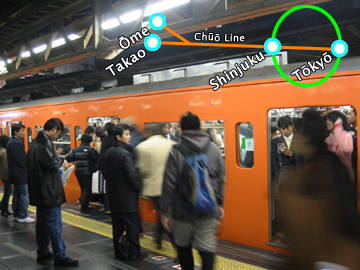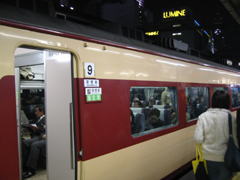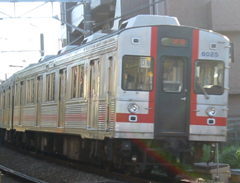Technique for getting a comfortable seat
Getting into a train, what will a passenger -- or you -- do next? If there are no other passengers, you will go to any seat and sit down.
But though there are some vacant seats between or next to others, you will probably hesitate about whether to sit there. Passengers seem to choose their seats artificially -- not at random.
Actually the seats are filled from their corners. In other words, they choose the seats at corners.
This involves a psychological phenomenon called Personal space.
It is the region surrounding each person, which if violated makes them feel uncomfortable (The Free Dictionary.com 2004).
Psychologist Hiroshi Motoaki (2001, 70) says that the personal space is within 50 centimeters in his/her circumference.
Therefore passengers prefer seats whose either or both side(s) nobody sits on.
Of course the best seat has both sides vacant, but this seat has a risk of being sat on either or both side(s). Then they finally choose the seats at corners, because it is separated from the walkway,
which secures their personal spaces; no one could sit on that side.
However, I still have a question: are the seats at corners really comfortable? I'll introduce other seats which are surely pleasant enough to spend your time in trains run by Tōkyū Corporation.
Which seats are comfortable and why?
 By a comfortable seat I mean one where it is easy to take a rest while sitting on it, because passengers, including I, seem to be tired and want to sleep on trains at the very least.
As evidence, Chūō Liners are always full of passengers. Taking these trains, the passengers can avoid taking deadly crowded trains.
However, we don't want to pay any extra money, if possible.
By a comfortable seat I mean one where it is easy to take a rest while sitting on it, because passengers, including I, seem to be tired and want to sleep on trains at the very least.
As evidence, Chūō Liners are always full of passengers. Taking these trains, the passengers can avoid taking deadly crowded trains.
However, we don't want to pay any extra money, if possible.

Chūō Liner
The Chūō Liner is a rapid-service train bound from Tōkyō and Shinjuku to Takao. It runs several times in mornings and evenings on weekdays. All passengers cannot take this train;
passengers are required to buy reservation tickets before boarding.
It means that a passenger buys a seat and comfortable travel for only ¥500. The same train bound for Ōme is called Ōme Liner. It is also crowded.
 You may think that the seats at corners are very comfortable. Actually passengers sitting on those seats seem to be relaxed, but I suggest some problems that could annoy them.
Please imagine that you are sitting on those seats:
You may think that the seats at corners are very comfortable. Actually passengers sitting on those seats seem to be relaxed, but I suggest some problems that could annoy them.
Please imagine that you are sitting on those seats:
- A bad-mannered passenger leans against your seat, and his/her back or backpack hits your head.
- In winter, every time that the train arrives at a station, a cold wind pierces you.
- In mornings and evenings, it is deadly crowded near the doors, so you are surrounded by passengers, and are kicked or stepped one.
I have used Tōkyū Tōyoko Line from my earliest recollections (about 15 years), and I have found seats that would bave been suitable for sleeping or relaxing.
Taking the Tōyoko Line, I always target the seat in the same way that I always try to follow in a line behind the middle one of bording position marks. The seat is next to the corner -- the second seat from the corner.
There are two features which are unique to the second seat. One is that if you would like to sleep on the seat, you can just lay your head on the window sill to hold on.
It means that each window sill is above the second seat and corresponds to the position of the head. It is convenient to sleep. And more, as the seats at corners are so popular that someone already sits there,
the second seats -- the seats next to corners -- are usually vacant because of the personal space that I mentioned above. Passengers mostly prefer not to sit beside someone,
so it indicates that they hardly sit on the second seats. So you can choose and sit on this seat.
Comparison and evaluation of the comfortable seats in each series of trains
Regrettably, not all the second seats in trains run by Tōkyū are suitable for sleeping. The main reason is the construction of each train.
Especially the window sills where we would lay our heads decide whether we can be deeply relaxed or not. There are eight series of trains running on the Tōyoko Line.
Below I will list six of them with my evaluation.

Series 5050 & Y500
 These trains of the series 5050 & Y500 have the best second seats that are suitable for sleeping. You can also hold your heads on the window sills.
Furthermore, they don't shake so much while running. In addition, passengers sitting on the third seats also hold their heads on another window sill.
These trains of the series 5050 & Y500 have the best second seats that are suitable for sleeping. You can also hold your heads on the window sills.
Furthermore, they don't shake so much while running. In addition, passengers sitting on the third seats also hold their heads on another window sill.
These trains were made in late 2003 or earlier. As their characteristic, they have walls by the seats at corners, so passengers sitting on the seats also may be able to sleep,
but still they may bother about passengers leaning against the seats.
How to distinguish: series 5050 & Y500 are quite unique in their fronts. Their front-windows are wide. And they have LCD displays above their doors inside of them. Y500 is the only cars that are colored blue.

Series 9000
 The seats of these trains are also suitable for sleeping. In particular, their cushions are softest of all Tōkyū's trains.
However, their window sills are not rounded like series 5050's, so passengers may be uncomfortable when the train shakes. In any case, they are appropriate enough.
The seats of these trains are also suitable for sleeping. In particular, their cushions are softest of all Tōkyū's trains.
However, their window sills are not rounded like series 5050's, so passengers may be uncomfortable when the train shakes. In any case, they are appropriate enough.
These trains were made in near 1989, but they don't look so old. As their characteristic, they have booth seats located in each end of cars. Sitting there, passengers can be relaxed.
How to distinguish: series 9000 looks like 8950 very much. Look at the side of the car. If the bottom of the side is straight, that is 9000.

Series 8590
 Not only the second seats, but also all ones of these trains are the worst of those six series. However, the second seats are still comfortable enough.
The faults are the noise and the seat environment. They roar quite loudly and shake a lot when they run fast. And their seats are slightly hard and rough.
Not only the second seats, but also all ones of these trains are the worst of those six series. However, the second seats are still comfortable enough.
The faults are the noise and the seat environment. They roar quite loudly and shake a lot when they run fast. And their seats are slightly hard and rough.
How to distinguish: series 8590 looks like 9000 very much. Look at the side of the car. If the bottom of the side is rounded, that is 8590.

Series 8000 (Interior remodeled)
 Their second seats are still pleasant in their soft sofas except for their window sills which are not rounded.
Their second seats are still pleasant in their soft sofas except for their window sills which are not rounded.
Their seats are as comfortable as those of series 9000, because they were replaced. Yet other inside facilities are still old. In particular, like series 8590,
their windows frequently jar when they speed up, which may wake passengers up.
How to distinguish: the center of its front is painted black. And there is a red line on the both sides of the car.

Series 8000
 Like series 8590, their second seats are not so comfortable. All their seats are hard and rough.
And the sharp window sills above the second seats also prevent passengers from relaxing.
Like series 8590, their second seats are not so comfortable. All their seats are hard and rough.
And the sharp window sills above the second seats also prevent passengers from relaxing.
They are the oldest trains of the eight series. Some of these trains were made in 1969. Their seats have some characteristics that indicate the changing times. For example, a couch of series 9000 can seat seven.
But even if seven passengers are seated on that of series 8000, there is still a space. It seems to have been expected that eight passengers would be seated, or the width of body have been wider.
How to distinguish: comparing with its remodeled one, series 8000 doesn't have a black face, and a red line on its sides. Now in 2005, only one train of series 8000 is running on Tōyoko line.
As the renaissance of series 8000's prototype, the red line is stripped from its face.
Finally, though what I felt comfortable can be different from what you feel, I mainly hope that you remember that not only the seats at corners are the best;
the second seats can also provide relaxing travel. With this information, you would be positive to choose seats other than those at the corners.
Work cited:
Motoaki Hiroshi (2001) Naze densha no seki wa ryōhashi ga ninki nanoka ("Why the seats of either end in trains are popular"). Futabaraifu Sinsho. Tokyo: Fusōsha.
[TOP]
[Intro] [Boarding] [Smoking] [Priority] [Phones]
[Vacant] [Comfort] [13th] [Shinjuku] [Hommoku]
Soliloquy of my Railway © Satoshi Oshio, 2004


 By a comfortable seat I mean one where it is easy to take a rest while sitting on it, because passengers, including I, seem to be tired and want to sleep on trains at the very least.
As evidence, Chūō Liners are always full of passengers. Taking these trains, the passengers can avoid taking deadly crowded trains.
However, we don't want to pay any extra money, if possible.
By a comfortable seat I mean one where it is easy to take a rest while sitting on it, because passengers, including I, seem to be tired and want to sleep on trains at the very least.
As evidence, Chūō Liners are always full of passengers. Taking these trains, the passengers can avoid taking deadly crowded trains.
However, we don't want to pay any extra money, if possible.
 You may think that the seats at corners are very comfortable. Actually passengers sitting on those seats seem to be relaxed, but I suggest some problems that could annoy them.
Please imagine that you are sitting on those seats:
You may think that the seats at corners are very comfortable. Actually passengers sitting on those seats seem to be relaxed, but I suggest some problems that could annoy them.
Please imagine that you are sitting on those seats:
 These trains of the series 5050 & Y500 have the best second seats that are suitable for sleeping. You can also hold your heads on the window sills.
Furthermore, they don't shake so much while running. In addition, passengers sitting on the third seats also hold their heads on another window sill.
These trains of the series 5050 & Y500 have the best second seats that are suitable for sleeping. You can also hold your heads on the window sills.
Furthermore, they don't shake so much while running. In addition, passengers sitting on the third seats also hold their heads on another window sill.
 The seats of these trains are also suitable for sleeping. In particular, their cushions are softest of all Tōkyū's trains.
However, their window sills are not rounded like series 5050's, so passengers may be uncomfortable when the train shakes. In any case, they are appropriate enough.
The seats of these trains are also suitable for sleeping. In particular, their cushions are softest of all Tōkyū's trains.
However, their window sills are not rounded like series 5050's, so passengers may be uncomfortable when the train shakes. In any case, they are appropriate enough.
 Not only the second seats, but also all ones of these trains are the worst of those six series. However, the second seats are still comfortable enough.
The faults are the noise and the seat environment. They roar quite loudly and shake a lot when they run fast. And their seats are slightly hard and rough.
Not only the second seats, but also all ones of these trains are the worst of those six series. However, the second seats are still comfortable enough.
The faults are the noise and the seat environment. They roar quite loudly and shake a lot when they run fast. And their seats are slightly hard and rough.

